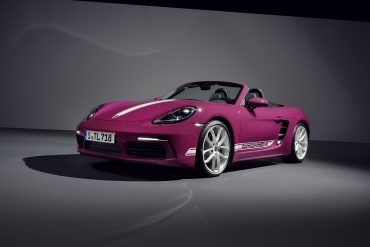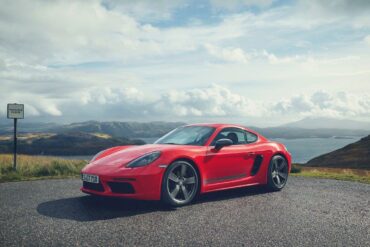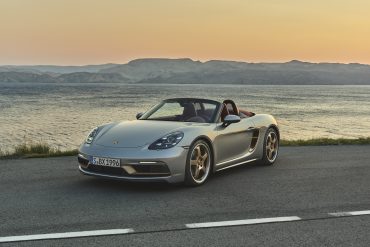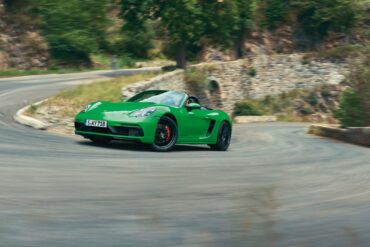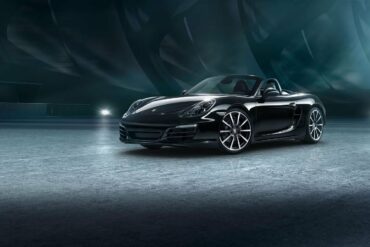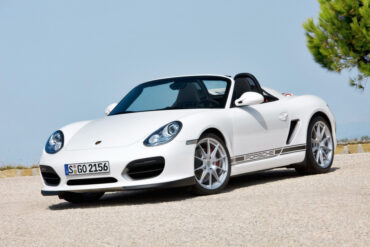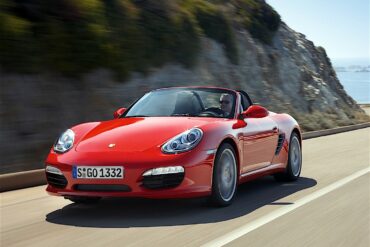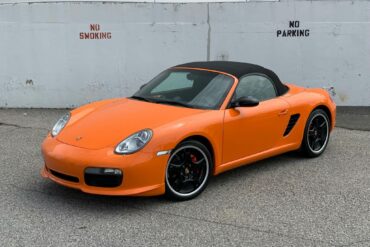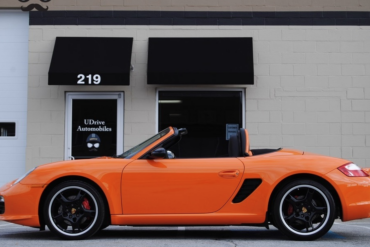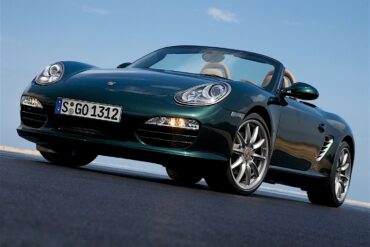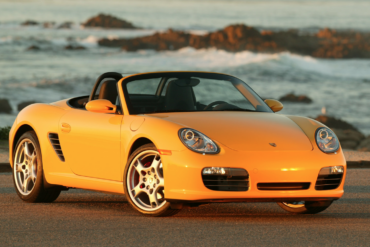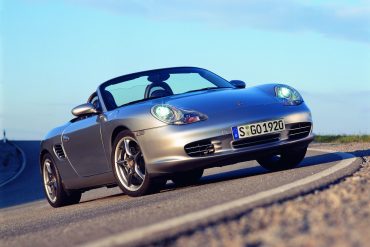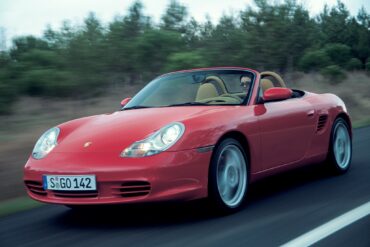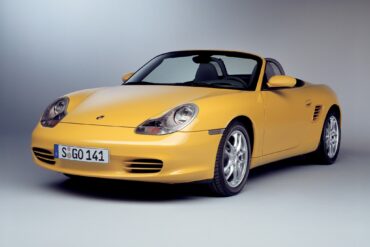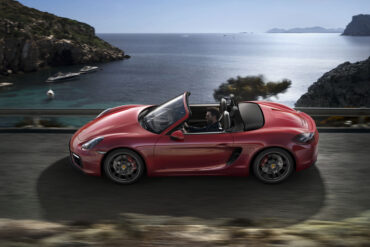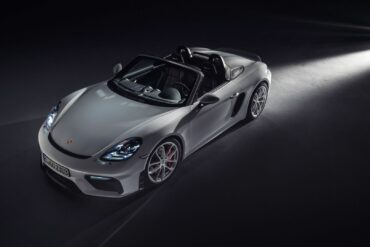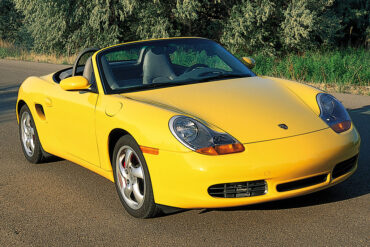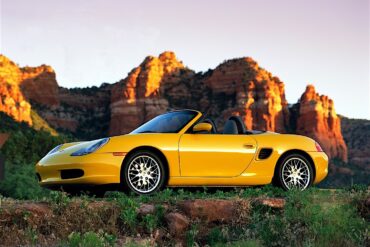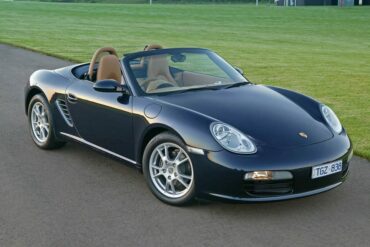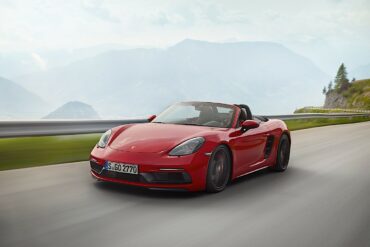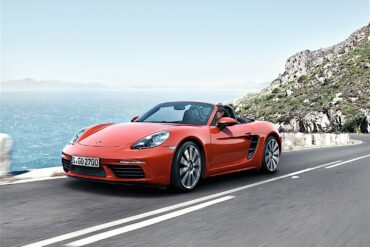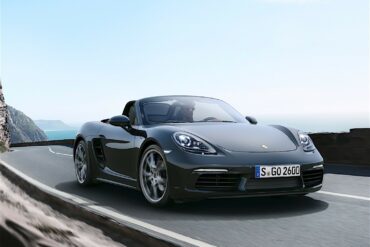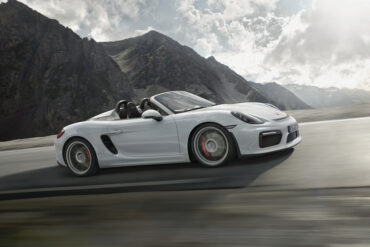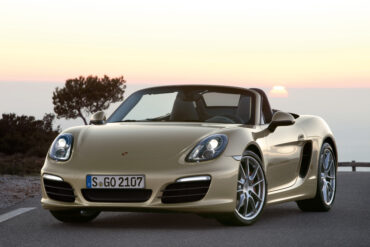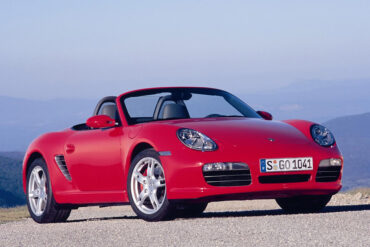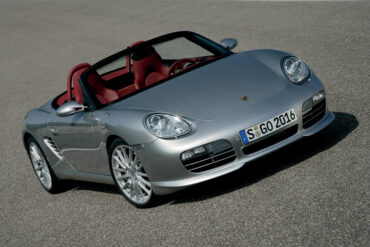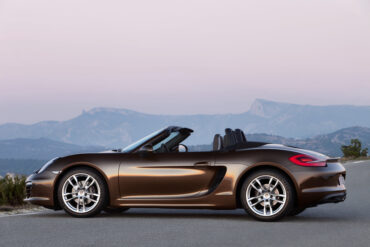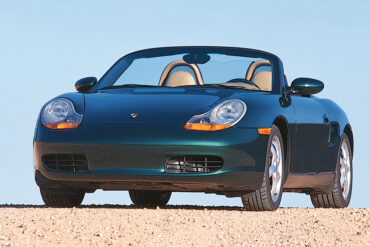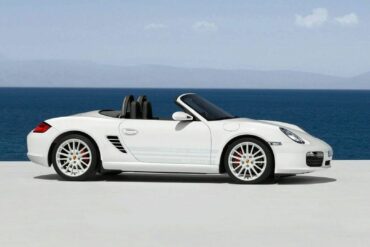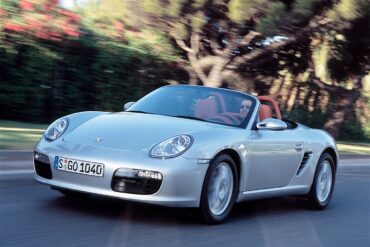Fresh colours and harmonious contrast packages characterise the new Porsche 718 Boxster Style Edition and 718 Cayman Style Edition sports cars. Available on the base model, this is a sweet package for the buyer looking to jazz up their base Cayman or Boxster and make them really special. Underlining Porsche’s commitment to ever more creative and vibrant bespoke finishes, the new models are characterized by special colors and matching contrasting elements. This is evident with the new color Ruby Star Neo, a modern interpretation of the color used on the 964 Carrera RS.
The Boxster 718 T was released for the 2020 model year as more sport-oriented versions of the base 718 models. As such, the T features the same 2.0-litre flat-4 engine as the base 718 but adds performance-oriented options such as Porsche's sport suspension system, the Sport Chrono package, and a limited-slip differential, along with minor cosmetic differences including special decals along the lower doors, a smaller-diameter steering wheel, door pull straps in place of standard door handles, wheels from the Porsche 992 Carrera S, and black rear badging.
Stuttgart. Porsche is celebrating the 25th birthday of its roadster family with a special anniversary model: the Boxster 25 Years. The limited edition is restricted to 1,250 units worldwide and is based on the GTS 4.0 model, which is powered by a 4.0-litre six-cylinder boxer engine with 294 kW (400 PS). It makes reference to numerous design features of the Boxster concept car that heralded the success story of the open-top two-seater at the 1993 Detroit Motor Show. The production version was launched in 1996 with hardly any changes in its visual appearance and is now in its fourth generation.
Essentially a liaison Boxster version situated between the 718 Boxster GTS and the hardcore 718 Spyder, the Porsche 718 Boxster GTS 4.0 offers a mix between the comfort and features found on the regular GTS and a detuned version of the engine found in the Spyder. Alongside its hardtop Cayman sibling, it is also one of the last production sports cars with a large displacement engine that doesn't feature turbocharging or supercharging. It produces 395 bhp @ 7800 rpm and 310 ft lbs @ 5000 rpm and can hit zero to 60 mph in 4.3 seconds (only 0.1 seconds slower than the Spyder).
The mid-engine roadster is powered by the 2.7 liter flat-six engine with 265 hp. Its color concept remains consistent with the soft top and supplemental safety bar which are both finished in black. The wind deflector reduces undesirable turbulence when the soft top is down. 20-inch Carrera Classic wheels and the Bi-Xenon™ headlights with Porsche Dynamic Light System (PDLS) set distinctive highlights, while standard two-zone air conditioning and heated seats provide a higher level of comfort for both driver and passenger. The Porsche Communication Management system is included as standard.
On 5 November 2009, Porsche officially announced the Boxster Spyder, which was the lightest Porsche on the market at the time, weighing 1,275 kg , 80 kg lighter than a Boxster S. This was achieved through the elimination of the conventional soft top's operating mechanism, the radio/PCM unit, door handles, air conditioning, storage compartments, cup holders and large LED light modules on the front fascia, although some of these could be re-added to the car in the form of options. Weight saving was also gained using aluminum doors, an aluminum rear deck and the lightest 19-inch wheels.
The 2008 facelift of the Boxster S is powered by a new direct-injection 3.4-liter Boxer engine which develops more power than the earlier variant. The styling got a bit updated with some redesigned headlight casings, taillights, and bumpers, while the interior got new infotainment and more material/color combinations. There's a revised 6-speed manual as well as a new 7-speed PDK gearbox. Performance improves, with power now at 310 hp, rocketing the 987.2 Boxster S from 0 - 60 mph in just 5.2 seconds and to a top speed of 170 mph.
Porsche gave us something special in 2008, the Limited Edition Boxster and Boxster S. Pricing started at $59,900 for the Boxster S version. The Limited Edition’s bright orange paint was previously featured on the race-ready Porsche 911 GT3 RS. The Limited Edition is equipped with a sport exhaust system, and safety bars (also painted orange). The SportDesign package is also included.
Porsche unveiled its 2008 Limited Edition Boxster and Boxster S models at a private gathering at the occasion of the 2007 New York Auto Show. Largely inspired by the 2007 911 GT3 RS, only 250 examples of each model were produced in brilliant orange. Other special exterior features included glossy black painted mirrors, alloy wheels, front and side air inlets, and model designation.
In 2008, the second generation of the Boxster received new technologies and more power. It reached almost the same power as the former Boxster S, from the first generation. The 2.9-liter unit replaced the older 2.7-liter engine and offered 10 hp more than the older engine. It was paired as standard to a 6-speed manual, and a 7-speed PDK (Porsche dual-clutch) automatic was available as an option. The outside gets some welcome design tweaks also, while on the inside we get some updates and more technology options.
For the 2007 model year, the base Boxster received a revised engine featuring VarioCam Plus to provide a 3.7 kW (5.0 hp) power increase (183 kW (245 hp) the same as the Cayman). The Boxster S' engine was upgraded from 3.2-litre to 3.4-litre, resulting in a power increase of 11 kW (15 hp) more (220 kW (295 hp) the same as the Cayman S). These upgrades made the Boxster series and the Cayman series equivalent in terms of power.
In 2004, the Boxster S Special Edition, also called 550 Spyder Boxster S Special Edition was introduced with a production run of just 1,953 cars (paying homage to the 550 Spyder's year of introduction). 500 cars were made for the US Market. These were all painted in GT Silver Metallic, the same colour as the Carrera GT concept presented in 2000, and had unique cocoa-brown full-leather interior as standard with grey natural leather as a no-cost option.
The Boxster S was revised along with its Boxster version in 2003. From the outside, the 2002 Boxster S featured an apron with three air-intakes, one more than the non-S version. The 3.2-liter unit was installed in the Boxster since 2000, but after the facelift it was improved by 10 hp, reaching 258 hp. It was paired as standard with a 6-speed manual, or a 5-speed Tiptronic (automatic) as an option. As expected, the manual version was quicker and faster.
The first generation Boxster got a facelift and refresh for the 2003 model year. The 2003 Boxster came on the market with new engines and new options. It also had a new face, but not that different than the first generation. The result was more horsepower, the 2.7 liter now good for 225 bhp @ 6300 rpm and 192 ft lbs @ 4750 rpm. Power was up by 8 horsepower over the prior year model, while torque was unchanged. From the outside, the 2002 Boxster featured an apron with two air-intakes on the sides.
The two most powerful and fastest mid-engine sports models from Porsche are ready and raring to go: with uprated engines and excellent PASM chassis the Boxster GTS and Cayman GTS set new benchmarks for sportiness in their segment. 3.4 L naturally aspirated flat 6 is good for 330 hp. Sport Chrono package is standard. This means that in conjunction with the optional Doppelkupplungsgetriebe (PDK) and the active Sport Plus button, the Boxster GTS sprints from 0-100 km/h in 4.7 seconds.
The 718 Boxster Spyder is everything you could possibly want in a sports car. The sublime combination of a legendary chassis and naturally aspirated 6-cylinder Porsche engine is accentuated by the emphasis that less is more when done right - and nobody does this better than Porsche’s GT division. Connections with these cars are visceral and emotional, an outcome mutually desired by both Porsche engineers and customers alike. They will never be considered tardy in the right hands. The Spyder is in my opinion, the best sports cars you can buy in this segment.
In 2000, Porsche gave us the Boxster S. With a 3.2 liter naturally aspirated Flat-6, it was good for 250 bhp and 225 ft lbs of torque, up by 25% on the base 2.7 liter Boxster. Hardward changes, a 6-speed gearbox and all this extra power and torque transformed the Boxster driving experience. From behind the wheel, the Boxster S rushes forward in a way that is missing from the base model, that torque increase really making itself known, especially in the midrange. 0 to 60 mph now takes 5.60 second (compared to 6.5 for the 2.7 L base model). Top speed is 161 mph and the quarter mile is 14.1 seconds.
While the original 986 Boxster was a sweet ride, its performance began to lag behind newer competitors like the Honda S2000. Powered by a 2.5-litre flat six-cylinder engine, the base model was upgraded to a 2.7-litre engine in the year 2000. The gearbox options in the Boxster 2.7 are the same as in 2.5, but they got new type designations due to improvements. Externally, the 986 Boxster 2.7 looks like Boxster 2.5. Inside the side airbags are standard and the plastic feeling has been reduced. The fuel tank is a larger 64-liter. Alcantara trim is available on the options list.
The 2007 model year Boxster got a change that most people don't think is significant, but is. Model year 2007 is when the base Cayman joined the 987 lineup. The interior and exterior remained mostly the same, but the Boxster S received the Cayman S 3.4-liter flat six while the 2.7 in both the Boxster and new Cayman received VarioCam Plus, which bumped horsepower up to 245. Think of this model year as Porsche taking the changes to get the base Boxster 2.7 to the same level as the recently introduced base Cayman.
In true Porsche GTS spirit, the output of the 2.5-litre, four-cylinder flat ‘boxer’ engine has been increased to 360 bhp courtesy of a new intake system and an optimized turbocharger. These improvements generate 15bhp more power compared with the 718 S model, and up to 35 bhp more power than the prior GTS models. A manual six-speed gearbox is standard, with the Porsche PDK available as an option. Standard equipment includes the Sport Chrono Package, Porsche Torque Vectoring (PTV) with a mechanical rear axle limited slip differential and Porsche Active Suspension Management (PASM).
While the first generation Boxster S was received with mixed feelings, the second generation was praised. With the introduction of the 718 Boxster, the car-maker showed a special commitment to the smallest member of the Porsche family and it arguably become the best sports car in the world. The Boxster S featured a 2.5-liter flat-four engine. It was turbocharged and with direct fuel injection and was good for 345 hp. Performance was up a lot, especially in the midrange, now that torque was 310 ft lbs. It helped rocket the Boxster S from zero to 60 mph in just 4.0 seconds and onto a top speed of 177mph.
Welcome to the four generation Boxster. The base Boxster was powered by a twin-turbo 2.0-liter direct-injection gasoline unit. It offered a total output of 300 hp and it was paired as standard with a 6-speed manual, while a 7-speed automatic (PDK – dual-clutch) was on the options list. In terms of design, it gets a more modern look and feel and the interior is upgraded. More tech, more power and more speed. The only downside is the loss of the aural pleasure of a flat 6 engine that is naturally aspirated and loves to rev to the sky.
Following in the footsteps of the nineteen fifties and sixties 356 Speedsters, 550 Spyders, different 718 Spyders and the two thousand ten Boxster 987 Spyder, the Boxster 981 Spyder is by far the most powerful of them. The power-to-weight ratio of the original 718 Spyder 1.7- and 2.0-litre 4-cylinder models was better though already 55 years earlier. Visually the Porsche Speedsters and Spyders are characterized by their unique side view silhouette - the result of the low windscreen and low roofline when the temporary canvas top is fitted.
Unlike its Boxster brother, the S version of the mid-engined Porsche roadster offered a 3.4-liter unit from its predecessor, but with some improvements and a lower vehicle mass. It offered 311 hp and enough torque to push the car to 100 kph (62 mph) in 4.8 seconds if the car was fitted with PDK (automatic dual-clutch). The two-seat roadster featured a clean design interior, with influences from the Carrera GT super sports-car. The Boxster S was the sweeter of the two models.
The second generation of Porsche Boxster came out in 2004 at the Paris Motor Show and shared almost the same design with its predecessor. The Boxster S came with the 3.2-liter flat-six engine mated to a standard 6-speed manual transmission, while a 5-speed Tiptronic S (automatic) with manual override to select gears was on the options list. The Porsche Stability Management was fitted as standard. It got a bump on power over the prior generation Boxster S as well as a newly modernized exterior design. The interior was also upgraded and was much nicer.
In November 2007, Porsche announced a commemorative RS60 Spyder edition of the Boxster to celebrate Porsche's 1960 win in the 12 Hours of Sebring in Florida. Only 1,960 units were produced worldwide with each model bearing a numbered production badge on the dash. The RS60 Spyder came only in GT Silver Metallic exterior colour while the standard interior is Carrera Red leather, with dark gray leather as an option. The RS60 came standard with 19 inch SportDesign alloy wheels, Porsche's Active Suspension Management System, and a sports exhaust that increased the engine output to 303 PS (299 hp; 223 kW).
The third generation Boxster was a bigger car than the 987 it replaced, but it was also lighter and more powerful. The 2013 model year Boxster went through a downsize program and received a 2.7-liter boxer engine, which was 0.2-liter smaller than its predecessor. With 261 bhp @ 6700 rpm and 206 ft lbs @ 4500 rpm the base Boxster still felt underpowered to many. The base 981 Boxster got a 6-speed manual gearbox or you could opt for an optional 7-speed reworked PDK. The base car is plenty fast but if it were our money, we would opt for the more powerful Boxster S.
It was Porsche's first road vehicle to be originally designed as a roadster since the 914. The first-generation Boxster (the 986) was introduced in late 1996 as a 1997 model year car. The V-Series Boxster 2.5 rolled out in August 1996 from Porsche’s factory in Zuffenhausen, Germany. The design was heavily influenced by the 1993 Boxster Concept (which was a good thing). It was an instant success, becoming Porsche's biggest seller from its introduction in 1996 until the introduction of the Cayenne sport utility vehicle in 2003.
The limited production Boxster S Porsche Design Edition 2 debuted in October 2008 as 2009 model. It featured a free-flowing exhaust system, which raised power from 217 kW (291 hp) at 6,250 rpm to 223 kW (299 hp) at an identical 6,250 rpm. It came in a unified Carrera White paint scheme with matching white 19-inch wheels, a black and grey interior with white gauges, red taillights and light grey stripes along the body. 500 were made for the worldwide market, 32 shipped into the U.S. and 18 into Canada.
The original Porsche Boxster was a huge success and help Porsche grow its customer base, so when the second-generation Boxster (987) came to the US market as a 2005 model it wasn’t a surprise that it followed a similar formula. While the 987 Boxster retained only 20 per cent of the 986’s DNA, it looked similar enough to us that it felt more like a mild refresh than a totally new model update. The engine and transmissions were, for the most part, carry-overs, albeit with the obligatory and customary modest bump in performance and power (now at 240 horsepower).


